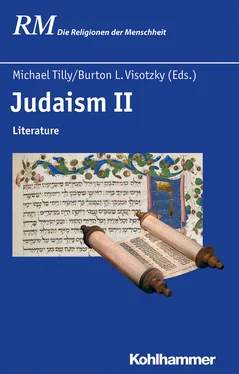Die Religionen der Menschheit
Begründet vonChristel Matthias Schröder
Fortgeführt und herausgegeben von
Peter Antes, Manfred Hutter, Jörg Rüpke und Bettina Schmidt
Band Band 27,2
Cover: The Duke of Sussex’ Italian Pentateuch (British Library MS15423 f35v) Italy, ca. 1441–1467.
Burton L. Visotzky/Michael Tilly (Eds.)
Judaism II
Literature
Verlag W. Kohlhammer
Translations: David E. Orton, Blandford Forum, Dorset, England.
1. Auflage 2021
Alle Rechte vorbehalten
© W. Kohlhammer GmbH, Stuttgart
Gesamtherstellung: W. Kohlhammer GmbH, Stuttgart
Print:
ISBN 978-3-17-032583-8
E-Book-Formate:
pdf: ISBN 978-3-17-032584-5
epub: ISBN 978-3-17-032585-2
mobi: ISBN 978-3-17-032586-9
All rights reserved. This book or parts thereof may not be reproduced in any form, stored in any retrieval system, or transmitted in any form by any means—electronic, mechanical, photocopy, recording, microfilm/microfiche or otherwise—without prior written permission of W. Kohlhammer GmbH, Stuttgart, Germany.
Any links in this book do not constitute an endorsement or an approval of any of the services or opinions of the corporation or organization or individual. W. Kohlhammer GmbH bears no responsibility for the accuracy, legality or content of the external site or for that of subsequent links.
Judaism, the oldest of the Abrahamic religions, is one of the pillars of modern civilization. A collective of internationally renowned experts cooperated in a singular academic enterprise to portray Judaism from its transformation as a Temple cult to its broad contemporary varieties. In three volumes the long-running book series ›Die Religionen der Menschheit‹ (Religions of Humanity) presents for the first time a complete and compelling view on Jewish life now and then – a fascinating portrait of the Jewish people with its ability to adapt itself to most different cultural settings, always maintaining its strong and unique identity. Volume II presents Jewish literature and thinking: the Jewish Bible; Hellenistic, Tannaitic, Amoraic and Gaonic literature to medieval and modern genres. Chapters on mysticism, Piyyut, Liturgy and Prayer complete the volume.
Prof. Dr. Michael Tilly is head of the Institute for Ancient Judaism and Hellenistic Religions at the Faculty of Protestant Theology at Tübingen University.
Prof. Dr. Burton L. Visotzky serves as Appleman Professor of Midrash and Interreligious Studies at the Jewish Theological Seminary of America (NYC).
Foreword
1 Die Wissenschaft des Judentums
2 World War II and Vatican II
3 Jacob Neusner resets the agenda
4 Martin Hengel, (Judaism and Hellenism)
5 The New Academy
6 Kohlhammer’s
The Jewish Bible: Traditions and Translations
Emanuel Tov
1 The Transmission of Hebrew Scripture in Jewish Channels
2 The Traditional Hebrew Text of the Bible: The Masoretic Text
2.1 The Medieval Masoretic Text and Its Forerunner, Proto-MT
2.1.1 Proto-MT and the Judean Desert Texts
2.1.2 The Socio-religious Background of the Judean Desert Texts
2.1.3 The Origins of the Proto-MT
2.1.4 How the Proto-MT Was Created
2.2 The Scribes of the Proto-Masoretic Text and Their Practices
2.2.1 Precision Copying
2.2.2 Rabbinic Traditions about the Use of Corrected Scrolls
2.3 The Forerunners of the Proto-Masoretic Text
2.3.1 Precise Transmission of Inconsistent Spelling
2.3.2 Internal differences within the various books
2.3.3 Scribal Marks
2.4 Key Characteristics of the Masoretic Text
2.4.1 Consistency in Spelling
2.4.2 Diversity
2.5 The Masoretic Text Compared with the Other Texts
2.6 Traditional Judaism’s Relationship to Other Text Traditions
2.7 Comparing Details in MT to Other Text Traditions
2.8 Variation in Editions of MT
2.8.1 The Leningrad and Aleppo Codices
2.8.2 Scholarly Editions
2.8.3 Translations: Ancient and Modern
2.8.4 Modern Translations
2.8.5 Translation Fashions
3 Biblical Scrolls from the Dead Sea
4 The Septuagint and the Other Greek Translations
4.1 The Septuagint
4.1.1 Name and Nature
4.1.2 Scope
4.1.3 Sequence of the Books
4.1.4 Original Form, Jewish Background, Place, and Date
4.1.5 Evidence
4.1.6 The Greek Language of the LXX
4.1.7 Translation Character and Textual Analysis
4.1.8 The World of the Translators
4.1.9 Hebrew Source of the LXX
4.1.10 The Greek Versions and Christianity
4.2 The Other Greek Translations
4.2.1 Kaige-Theodotion
4.2.2 Aquila
4.2.3 Symmachus
4.3 Targumim
4.3.1 Targumim to the Torah
4.3.2 Targum to the Prophets
4.3.3 Targumim to the Hagiographa
5 Summary
For Further Reading
Jewish Literature in the Hellenistic-Roman Period (350 BCE–150 CE)
Michael Tilly
1 Introduction
1.1 Judaism and Hellenism
1.1.1 Koine
1.1.2 Texts and Traditions
2 Historical and Legendary Texts
3 Fragments of Hellenistic-Jewish Historians
4 Teachings in Narrative Form
5 Teachings in Didactic Form
6 Poetic Writings
7 Apocalyptic Literature
8 Dead Sea Scrolls
9 Philo of Alexandria
10 Flavius Josephus
For Further Reading
Tannaitic Literature
Günter Stemberger
1 Mishnah and Tosefta
1.1 Mishnah
1.1.1 Contents
1.1.2 Origins
1.1.3 Purpose of the Mishnah
1.1.4 Literary form, publication and authority of the Mishnah
1.1.5 The text, its transmission and its commentary
1.2 Tosefta
1.2.1 Contents
1.2.2 Origins
1.2.3 The Relationship between Tosefta and Mishnah
1.2.4 The text of the Tosefta, its transmission and commentary
2 Tannaitic Midrashim
2.1 General observations
2.2 The Mekhilta de-Rabbi Yishmael
2.2.1 Contents and Structure
2.2.2 Character and Date
2.2.3 The Text, its Transmission and Translations
2.3 The Mekhilta de-Rabbi Simeon ben Yoḥai
2.3.1 Text
2.3.2 Contents and Character
2.4 Baraita de-Melekhet ha-Mishkan
2.5 Sifra
2.5.1 Contents and Structure
2.5.2 The Literary Program of Sifra
2.5.3 The Unity of Sifra
2.5.4 The Text of Sifra, its Transmission and Translations.
2.6 Sifre Numbers
2.6.1 Contents and Structure
2.6.2 Character and Date
2.6.3 Text, Translation, and Commentaries
2.7 Sifre Zutta to Numbers and Deuteronomy
2.7.1 Sifre Zutta to Numbers
2.7.2 Sifre Zutta to Deuteronomy
2.8 Sifre Deuteronomy
2.8.1 Contents and Structure
2.8.2 Character and Date
2.8.3 Text and Commentaries
2.9 Midrash Tannaim (Mekhilta on Deuteronomy)
2.10 Seder ʿOlam
For Further Reading
Amoraic Literature (ca 250–650 CE): Talmud and Midrash
Carol Bakhos
1 Amoraim
2 Disciple Circles and Study Halls
3 The Talmuds
3.1 The Palestinian Talmud (The Yerushalmi)
3.2 The Babylonian Talmud (The Bavli)
4 Midrash
4.1 Midrashic Compilations
4.2 Genesis Rabbah
4.3 Lamentations (Eikhah) Rabbah
4.4 Song of Songs (Shir ha-Shirim) Rabbah
4.5 Leviticus Rabbah
4.6 Pesikta de Rav Kahana
4.7 Ecclesiastes Rabbah
5 Conclusion
For Further Reading
Rabbinic-Gaonic and Karaite Literatures
Burton L. Visotzky and Marzena ZawanowskaIn memory of our dear colleague and friend Ilana Sasson. Burton L. Visotzky wrote the section on Rabbinic-Gaonic literatures. Marzena Zawanowska wrote on Karaite literature.
1 Rabbinic-Gaonic literatures (ca. 650–1050 CE)
1.2 Gaonic Mishnah and Talmud Commentaries, Introductions
Читать дальше







